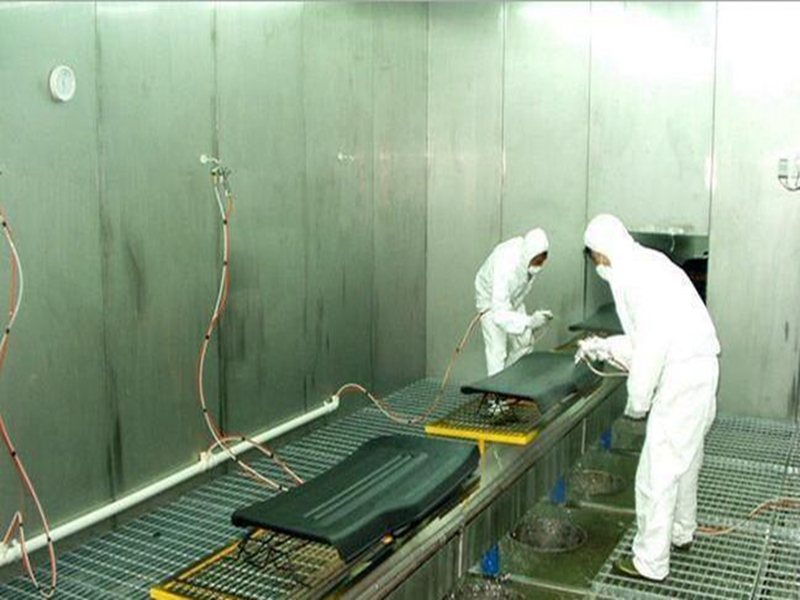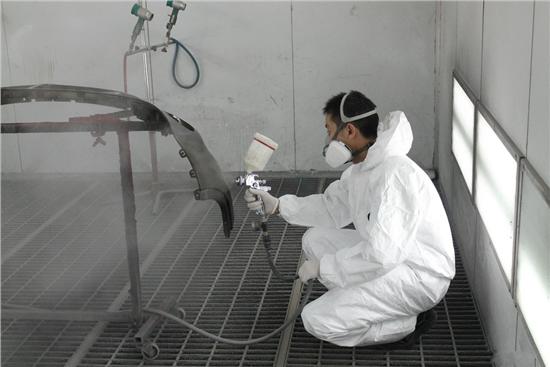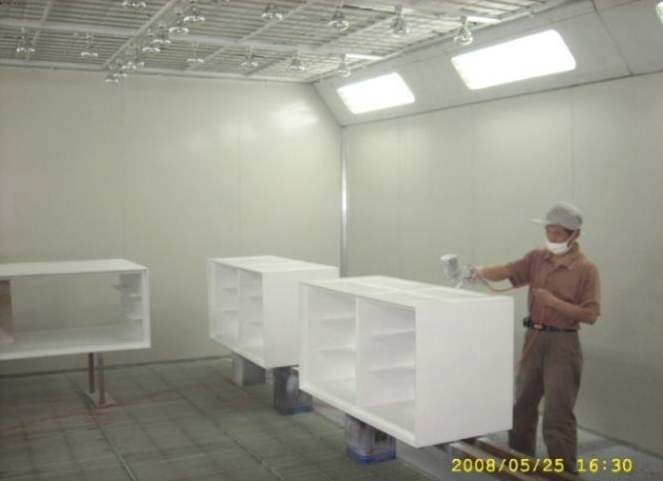Introduction
1. A method of applying a uniform and fine mist droplet to a surface of a coated object by means of air pressure by means of air pressure. (It can be divided into air spray paint, airless spray paint and electrostatic spray paint, etc.) Painting method)
2. A kind of artificial paint, made of resin, pigment, solvent, additive, etc. It is usually sprayed evenly on the surface of the object with a spray gun, and then the paint is dried and solidified to form a hard coat film. It has the functions of protection, beauty and marking, and is mainly used in automobiles, airplanes, wood, leather and so on. The substance is toxic and has a certain impact on the body. Different brands of spray paint have different toxicity due to different ingredients. Special care should be taken when using it to avoid inhalation and skin contact.

Painting classification
Classification criteria:
1. Classification by type: manual painting and automatic painting.
2. According to the variety of car paint: alkyd paint, acrylic paint, water paint.
The standard of painting, according to the volume (European Paint USA company standard) can be divided into 200 and 400ml two different sizes of paint.
3. According to the brightness, it is divided into high light (also called bright light), semi-matte, and matte (also called full dumb).
Paint brightness problem:
The unit of paint gloss is degree: bright light ≥ 90 degrees, 50 degrees ≤ semi-matte ≤ 70 degrees, matte ≤ 30 degrees. Often interpreted as a few points of light, in general, the light is a nine-point light, the semi-matte is a five-point or six-point light, and the matte is a three-point light.
The difference between bright and matte in the formulation is mainly the addition of matte powder (also called matting powder) to the matt paint, which causes the paint surface to form a diffuse reflection, thereby achieving the effect of matting.
Is the gloss as bright as possible?
High-brightness lacquered furniture, the sense of beauty will be more vivid, high gloss, smooth and smooth. However, it is easy to leave obvious traces after contact with people or other items, including indoor dust, which may appear to be dirty and need to be cleaned from time to time.
Furniture with low-brightness finishes feels less, but it looks darker.
In addition, the brightness of the paint is mostly PU (polyester) properties, the paint surface is very hard, as long as the paint is no problem, it will not be easy to wear, and will not crack.
Painting notes:
1. Spray the paint into a mist on the object to be coated with compressed air. (To include plastic, wood, metal)
2. Automatic painting is to inject the paint and gas into the jar for convenient transportation and storage. Very convenient to use.
3. How to use acrylic paint:
a. Suggested selection Select the size and quantity according to 0.8m/200ml. For the same color of the same work, it is best to select the same batch of products to avoid regional chromatic aberration.
b. Before spraying, it is recommended to select a similar product for the simulation test. In order to achieve the desired results.
c. Shake the product evenly up and down for 2 minutes before use, and mix the paint and gas with the built-in glass ball. For the best results.
d. Press the nozzle 25-35cm away from the spray surface, and evenly move the spray can to reach a spray strip, spray up and down to produce the spray surface. Do not spray continuously at one point, which will cause backflow (tears).
e. After use, if there is any remaining in the tank, it must be reversed, that is, the tank is inverted and sprayed 2~5 times to clean the remaining gas in the pipeline. Otherwise, the product will be discarded after 1 hour.

Paint hazard
Hazard: Spraying paint without protection, the concentration of benzene in the air of the workplace is quite high, which is extremely harmful to paint sprayers. Long-term exposure to benzene can cause chronic poisoning, resulting in leukopenia, thrombocytopenia, bone marrow hematopoietic dysfunction and other diseases. The harm to the human body can not only occur through the inhalation of the lungs, but also through the skin. The human skin is directly in contact with the paint, which can dissolve the fat in the skin, causing the skin to crack and inflame while entering the human body. Car painting is one of the important contents of car beauty. Workers will inevitably be exposed to benzene during work, and must be protected, and the work duration should not exceed 30 minutes. If the human body ingests too much benzene, aplastic anemia will occur, and leukemia will occur. Therefore, the protective configuration must be prepared when painting, while limiting the working time, and the working place should have good ventilation.
Painting process
Degreasing
1. Remove the oil stain on the surface of the ferrous metal workpiece during the production process, using the tank immersion method. The lye cleaning formula: sodium hydroxide 4%, sodium phosphate 4%, trisodium phosphate 4%, OP-10 emulsion 0.3%, temperature 90~95°C, processing time is 5~8 minutes. Post-treatment inspection method: After washing, brush with a brush and visually check whether the oil is clean.
2. Remove the oil stain on the surface of the non-ferrous metal workpiece, using the tank dip method. Use KL-13 type degreasing and deodorizing additive treatment (the additive is white powder), use concentration: 2% water ratio, temperature greater than 5 °C (such as plus The temperature treatment speed is increased), the time is 5~10 minutes, and the pH value of the bath is 7.
3. The surface of the plastic product is degreased and the tank is immersed. KL-16 type dewaxing and degreasing powder is used. The concentration is 5%, the temperature is 40~65°C, and the time is 5~10 minutes.
Cleaning
Wash with water after degreasing.
Rust removal
Acid rust removal to remove rust on the steel surface, using tank immersion method. Pickling rust removal formula: industrial hydrochloric acid with a concentration of 31%, corrosion inhibitor 3%, temperature: normal temperature. Treatment time 3~8 minutes, after treatment Inspection method: Visually check whether there is rust after washing.
Cleaning
Rinse with water after descaling.
Tune
For the surface treatment before phosphating, using the tank dipping method (the surface adjustment agent is white powder). When adding the bath liquid, slowly add it every 1~3 kg/ton, stir to dissolve it. The working condition of the surface conditioner is pH 7.5~9.5, temperature: normal temperature, half a minute.
Phosphating
The surface of the steel is phosphatized with a zinc-based phosphating solution.
1. Preparation of bath: add 3/4 volume of water in the tank, add A agent every 25~30 kg/ton, then add sodium hydroxide dissolved in hot water (according to 0.7 kg/ton) Finally add water to the working level to confirm the acidity. When the phosphating is about to start, add C agent every 0.5~0.7 kg / ton, stir and wait until use.
2. Using process parameters: total acidity 18~35 points, free acidity 0.5~1.5 points, accelerator 2~3 points, temperature 35~45°C, phosphorus immersion time 5~10 minutes, inspection method: water washing, visual observation of phosphorus after drying The film should be tile gray, crystallized finely, without spots, and solid deposits such as oxides that are not phosphatized remain on the surface. After phosphating, the water should be thoroughly washed and dried quickly after washing.
3. Phosphating solution management: After the continuous use of phosphating solution, the total acidity can be diluted with water. When the total acidity decreases, the addition of B agent per 1.6 kg/ton can increase by 1 point. When the free acidity rises, it should be every 0.4 kg/ton. Adding sodium hydroxide can reduce the free acidity by 1 point. If the free acidity is decreased, the B agent can be added every 6 kg/ton. The free acidity can be increased by 1. The bath temperature is too low or the C agent is added too much or the B agent is insufficient. The free acidity may drop below 0.4. When this happens, the B agent should be added every 0.9 kg/ton, and the free acidity increases by 0.1 point. When the C agent is added too much to produce a colored film, it can be stirred or heated to accelerate it naturally. Volatile.
Cleaning
After phosphating, rinse with water.
Dry
After phosphating and cleaning, the workpiece to be painted is dried.
Spray paint
The following tasks must be done before spraying: 1 Select the type of coating 2 Check the performance of the coating 3 Stir the coating thoroughly 4 Adjust the viscosity of the coating 5 Purify the paint 6 Paint color adjustment
When spraying, select the appropriate coating and the appropriate viscosity according to the workpiece to be sprayed, depending on the type of coating, air pressure, nozzle size and the amount of surface to be sprayed. 1 Nozzle diameter is 0.5mm~1.8mm 2 The air pressure supplied to the spray gun is generally 0.3~0.6Mpa. 3 The distance between the nozzle and the surface to be sprayed is generally 20~30cm. 4 The direction of the paint flow should be perpendicular to the surface of the object. During operation, the edge of each spray strip should overlap the edge of the previously sprayed strip (with an overlap of 1/3), and the speed of the spray gun should be uniform and uniform, not fast and slow.
Dry
1. General ABS, PC and other plastic self-drying paint baking temperature is 55~65 °C, the time is 30~35 minutes.
2. Drying polymer coatings, such as amino paint, acrylic paint, epoxy paint, etc., the general baking temperature is 130~140 °C, (acrylic paint should be kept for 10 minutes and then baked) 30~35 minutes .

Quality inspection
1. Check the dryness of the paint film, visually check or use a blade to check the thickness of the paint film. Use a Mitsubishi pencil to test the hardness, which should be around 3H.
2. Check the adhesion of the paint film and use the No. 11 surgical blade for the cross-cut test. During the test, the plane of the blade was perpendicular to the test surface, the force was uniform, the progress was smooth, and 4 scratches were cut vertically and horizontally to the surface of the substrate to form 9 small squares. The area of each small square was 1 mm. Gently reciprocate 5 times in the diagonal direction of the square array to observe the peeling of the paint film. Non-destructive adhesion measurement method: Adhesive tape can be glued to the surface of the paint film and then pulled open to check its adhesion.
3. Check the color, gloss and surface condition of the coating. Color and gloss visual inspection should meet the standard requirements, use a photometer to measure the gloss. Check the paint surface should be free of sand or dust, light color is uniform, no wrinkles, bubbles, cracks, rubber, sag, spots, pinholes, Bleeding or shrinkage.

